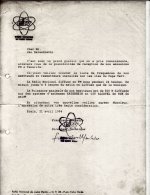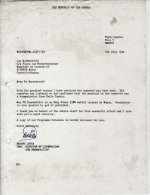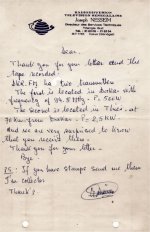I designed FM/AM/DAB radio chips professionally for many years in my previous job and there are many millions of FM radios around with the technologies I wrote about, but unfortunately I am not allowed to share any details.
Regarding DSP techniques, please see post #30. As an example of a radio using a harmonic reject mixer in its stereo decoder (albeit not a very good one), there is this: http://www.kako.com/neta/2007-006/tea5777.pdf
Regarding DSP techniques, please see post #30. As an example of a radio using a harmonic reject mixer in its stereo decoder (albeit not a very good one), there is this: http://www.kako.com/neta/2007-006/tea5777.pdf
Last edited:
Fascinating chip that TEA5777. Never heard of it. Its design is way above my pay grade. From the time that Philips still made real products...
As for that XOR: I have a Revox A720 preceiver (with nixies!) which uses a delay line and multiplier (LM1496) as FM demodulator. Works very well. I have no distortion figures but they should be low.
As for that XOR: I have a Revox A720 preceiver (with nixies!) which uses a delay line and multiplier (LM1496) as FM demodulator. Works very well. I have no distortion figures but they should be low.
I designed FM/AM/DAB radio chips professionally for many years in my previous job
That is, I was one of the designers, as they are so complex nowadays that they are designed by teams.
That put a bit clarity on your previous posts. I still sense that your exposure to FM is quite different from mine which explains how replies from one doesn’t quite line up with the other’s post.
I’m actively engaged with FM stereo tuners and have stopped acquiring test equipments for my home lab. My last and final are a couple of professional vector network analyzers. A journey I started more than 35 years ago with my analog meter kit ordered through mail order.
I’m still wondering about one of your comments on post #36 about IF filter suppressing the 5th harmonic. I have a feeling we are talking about 2 different audio applications. Mine is with high end audio where I don’t even bother with narrow IF, just wide and super wide IF. Car applications on the other hand where 110kHz and 150kHz IF bandwidths are normal, 5th harmonic artifacts are minimized significantly at the expense of audio quality. There is also the geographic location where measurement standards are different for FM deviation, 40kHz vs 75kHz. One accustomed to 40kHz deviation will naturally see a 110kHz IF filter as something that is used normally. With my point of view and application in mind, the narrowest I would use with hesitation is a 180kHz IF filter. This is me as an engineer figuring out as to the why so my assumptions could be wrong, feel free to correct me.
I’m actively engaged with FM stereo tuners and have stopped acquiring test equipments for my home lab. My last and final are a couple of professional vector network analyzers. A journey I started more than 35 years ago with my analog meter kit ordered through mail order.
I’m still wondering about one of your comments on post #36 about IF filter suppressing the 5th harmonic. I have a feeling we are talking about 2 different audio applications. Mine is with high end audio where I don’t even bother with narrow IF, just wide and super wide IF. Car applications on the other hand where 110kHz and 150kHz IF bandwidths are normal, 5th harmonic artifacts are minimized significantly at the expense of audio quality. There is also the geographic location where measurement standards are different for FM deviation, 40kHz vs 75kHz. One accustomed to 40kHz deviation will naturally see a 110kHz IF filter as something that is used normally. With my point of view and application in mind, the narrowest I would use with hesitation is a 180kHz IF filter. This is me as an engineer figuring out as to the why so my assumptions could be wrong, feel free to correct me.
When you have a 180 kHz wide IF filter (which would be rather narrow for FM stereo), its passband would range from 90 kHz below to 90 kHz above the carrier. During soft passages, where the noise matters most, noise at a distance delta f from the carrier ends up at a frequency delta f in the multiplex signal. Hence, the noise above 90 kHz is (somewhat) suppressed by the IF filter. With a 256 kHz wide IF filter, the same holds above 128 kHz.
I’m not expecting a reply about filter bandwidth.
You are still quoting in powers of 2 which suggests you are still in the digital and DSP realm.
This is an analogue DIY forum and I’m sticking and talking about real world analog FM stereo tuner hands-on experience today that I can easily validate, confirm, replicate and do over and over again.
You are still quoting in powers of 2 which suggests you are still in the digital and DSP realm.
This is an analogue DIY forum and I’m sticking and talking about real world analog FM stereo tuner hands-on experience today that I can easily validate, confirm, replicate and do over and over again.
The concern about impressive performance seems misplaced on FM broadcast radio.
Steely Dan- FM (No Static At All) - YouTube
Steely Dan- FM (No Static At All) - YouTube
Maybe tuners are not that popular a music source compared to other sources for that. For me, commercial interests have ruined FM in my area. If it weren't for NPR I'd not even own one.
Nowadays in Central America too, with a few exceptions and usually a case of local, low power stations. During the 1990s in Tenerife (Canary Islands) that was very different. With the feedback PLL I could receive signals from ~2000 Km distance that were inaudible on commercial radios, even at much higher altitude. RNCV (see photos) even transmitted 24/7 with "music only" at night.
But according to simulation my feedback PLL (designed / constructed) in 1976 was suboptimal and I'm curious enough to make a "nearly ideal" version.
Attachments
@ej25awd Do you tend to measure noise during silence or SINAD with 75 kHz deviation or something in between? My line of reasoning doesn't apply when there is a large frequency deviation.
I’d like to give you how I measure it but I’d like to know first your own method of measuring noise, equipment you (would) use to accomplish this and please specify the type of FM detector.
Well,
at my age the 15kHz cut off doesn't bother me much. I recall a few years back a live to air concert like they don't seem to do much of these days. Live to Air on FM was awesome with a good signal and well aligned Tuner.
What bothers me now is the CDs they are playing suffer of loudness wars and then they on top of that process the audio with the Orban audio processors or others so you get a "double whammy". So the same CD sounds much worse. I have one tuner with an FM deviation meter that confirms what my ears are telling me each time. A few radio stations minimize the audio processing and fewer still are actually careful about the recordings they chose to play so that leaves only a handful of stations worth listening to on the entire band in my market. The two public radio stations and the two university stations, the rest is all "double whammy" music which I don't need except for background and for that I often revert to streaming options as background to avoid ads.
But in my experience good source material on well executed station with a good reception end can be very satisfying as a source next to vinyl or CD.
at my age the 15kHz cut off doesn't bother me much. I recall a few years back a live to air concert like they don't seem to do much of these days. Live to Air on FM was awesome with a good signal and well aligned Tuner.
What bothers me now is the CDs they are playing suffer of loudness wars and then they on top of that process the audio with the Orban audio processors or others so you get a "double whammy". So the same CD sounds much worse. I have one tuner with an FM deviation meter that confirms what my ears are telling me each time. A few radio stations minimize the audio processing and fewer still are actually careful about the recordings they chose to play so that leaves only a handful of stations worth listening to on the entire band in my market. The two public radio stations and the two university stations, the rest is all "double whammy" music which I don't need except for background and for that I often revert to streaming options as background to avoid ads.
But in my experience good source material on well executed station with a good reception end can be very satisfying as a source next to vinyl or CD.
My colleagues from the validation team usually measured stereo noise either with a carrier that's only modulated with a 19 kHz, 6.75 kHz peak deviation pilot tone, or with a signal that has a pilot tone and a 1 kHz, 22.5 kHz peak deviation audio signal (for SINAD measurements). There was usually a 15 kHz low-pass between the audio outputs and the audio analyser to remove pilot tone residues. The audio analyser was typically a Rohde and Schwarz UPV and the signal generator an SMA100. The FM detector was whatever was used in the chip to be evaluated and there would be a dummy antenna between the signal generator and the evaluation board of the chip under test. Distortion tests would of course be done with the full 75 kHz deviation, and often a bit beyond that.
@ej25awd In any case, I'm not interested in what equipment you use, but in what you measure.
In post #45, I've given a very simple theoretical reason why noise around 190 kHz in the multiplex signal has to be suppressed by the IF filter to some extent, at least when there is no strong audio signal present, and instead of accepting it or pointing out a mistake you give these weird comments like "I’m sticking and talking about real world analog FM stereo tuner hands-on experience today that I can easily validate, confirm, replicate and do over and over again."
That makes me wonder what measurements you've done that show that the noise of the multiplex signal does not roll off at half the IF filter bandwidth. Of course you have the 20 dB/decade upwards slope of the noise density that's inherent in FM demodulation (triangle noise), maybe that obscures the roll-off? Or you measured with strong modulation, so the reasoning of post #45 doesn't apply?
In post #45, I've given a very simple theoretical reason why noise around 190 kHz in the multiplex signal has to be suppressed by the IF filter to some extent, at least when there is no strong audio signal present, and instead of accepting it or pointing out a mistake you give these weird comments like "I’m sticking and talking about real world analog FM stereo tuner hands-on experience today that I can easily validate, confirm, replicate and do over and over again."
That makes me wonder what measurements you've done that show that the noise of the multiplex signal does not roll off at half the IF filter bandwidth. Of course you have the 20 dB/decade upwards slope of the noise density that's inherent in FM demodulation (triangle noise), maybe that obscures the roll-off? Or you measured with strong modulation, so the reasoning of post #45 doesn't apply?
During the 1990s in Tenerife (Canary Islands) that was very different. With the feedback PLL I could receive signals from ~2000 Km distance that were inaudible on commercial radios, even at much higher altitude.
Cool! What loop bandwidth did you use, 15 kHz or less than that to get more threshold extension? Maybe even use the PLL roll-off for de-emphasis, so you can make it really narrow?
Last edited:
MarcelvdG,
I measure FM stereo tuner noise based on the IEEE 185-1975 standard with a bit of difference. I don’t use the specified 200Hz-15kHz 3rd order bandpass filter and averaging meter but instead use a 22Hz-22kHz bandpass filter and RMS meter that are built-in features of the Audio Precision System Two. Sanity checks are performed regularly to make ensure the numbers I measure are real. My noise measurements are far more stringent and realistic. The IEEE standard with its 200Hz cutoff conveniently exclude power supply noise that exists in the line-powered DUT. My noise measurements include most of the DUT’s power supply-induced noise and include more of the pilot leakage contribution. I use FFT to characterize the noise composition in order to identify the noise source.
Look at my heavily modified Nikko Gamma V FFT measurements here:
Sansui TU-X1 done by an audio engineer - ej25awd
Note the Gamma V power supply noise contribution from the 60Hz line and the rectified 120Hz supply. The noise floor of this one of a kind Gamma V is around -80dB.
I have my own noise measurement test that is for characterizing an FM Stereo tuner’s susceptibility to SCA, RDS/ARI and IBOC noise.
Do you know the actual R&S SMA100 residual FM noise and FM linearity at 76MHz-108MHz and linearity with 75kHz FM deviation? The SMA100 spec sheet I read isn’t that specific about these.
I measure FM stereo tuner noise based on the IEEE 185-1975 standard with a bit of difference. I don’t use the specified 200Hz-15kHz 3rd order bandpass filter and averaging meter but instead use a 22Hz-22kHz bandpass filter and RMS meter that are built-in features of the Audio Precision System Two. Sanity checks are performed regularly to make ensure the numbers I measure are real. My noise measurements are far more stringent and realistic. The IEEE standard with its 200Hz cutoff conveniently exclude power supply noise that exists in the line-powered DUT. My noise measurements include most of the DUT’s power supply-induced noise and include more of the pilot leakage contribution. I use FFT to characterize the noise composition in order to identify the noise source.
Look at my heavily modified Nikko Gamma V FFT measurements here:
Sansui TU-X1 done by an audio engineer - ej25awd
Note the Gamma V power supply noise contribution from the 60Hz line and the rectified 120Hz supply. The noise floor of this one of a kind Gamma V is around -80dB.
I have my own noise measurement test that is for characterizing an FM Stereo tuner’s susceptibility to SCA, RDS/ARI and IBOC noise.
Do you know the actual R&S SMA100 residual FM noise and FM linearity at 76MHz-108MHz and linearity with 75kHz FM deviation? The SMA100 spec sheet I read isn’t that specific about these.
I experimented with delay quadrature detectors for very wide band FM video detectors 35 years ago. I found getting good linearity with no kinks and ripples was not so easy in practice.
For broadcast audio, the output level will be tiny unless you use a low IF, which then requires a large delay.
For broadcast audio, the output level will be tiny unless you use a low IF, which then requires a large delay.
What kind of delay line did you use and what caused the kinks and ripples?
In principle the output level need not be tiny, because you can also use a large delay at high IF. You will get a periodic, triangle-wave-like relation between frequency and demodulator output signal, but as long as the complete channel is on one line segment, it doesn't matter. The Studer B760 uses a 3/4 period delay (68 ns, must be about 13.6 metres of coaxial cable with a velocity factor of 2/3). I'm not sure if the same holds for the A726.
In principle the output level need not be tiny, because you can also use a large delay at high IF. You will get a periodic, triangle-wave-like relation between frequency and demodulator output signal, but as long as the complete channel is on one line segment, it doesn't matter. The Studer B760 uses a 3/4 period delay (68 ns, must be about 13.6 metres of coaxial cable with a velocity factor of 2/3). I'm not sure if the same holds for the A726.
I have my own noise measurement test that is for characterizing an FM Stereo tuner’s susceptibility to SCA, RDS/ARI and IBOC noise.
Could you elaborate on that?
As far as I can tell, neither my colleagues' measurements nor your standard noise measurements say anything about whether the noise density at the multiplex signal falls off above half the IF bandwidth. Maybe your IBOC test does, directly or indirectly?
Do you know the actual R&S SMA100 residual FM noise and FM linearity at 76MHz-108MHz and linearity with 75kHz FM deviation? The SMA100 spec sheet I read isn’t that specific about these.
I probably mixed up the SMA100 and SMB100A. The SMB100A has a maximum FM distortion of 0.2 %, see page 20 of https://scdn.rohde-schwarz.com/ur/p...t_30/SMB100A_dat-sw_en_5213-8396-22_v0900.pdf , but somehow my colleagues manage to measure distortion levels well below 0.1 %. I don't know if they use the internal or an external generator (like the UPV's generator) for the modulating tone.
- Status
- This old topic is closed. If you want to reopen this topic, contact a moderator using the "Report Post" button.
- Home
- Source & Line
- Analogue Source
- FM Discriminator With XOR Gate


